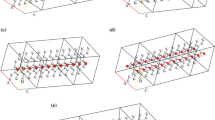Abstract
We obtained n-type and p-type modified graphene by mixing quantum dots and depositing electron-acceptor molecules on the surface of graphene, respectively. The electrical and optical properties of these two types of samples were measured. For n-type modified graphene, the electrons were transferred from quantum dots to graphene. The resistance of these quantum dots in modified n-type graphene is significantly smaller than that of pristine graphene. For p-type graphene, modified by electron-acceptor organic molecules of tetracyanoethylene (TCNE), electrons were transferred from graphene to TCNE molecules. The resistance of this molecular modified p-type graphene is about 10% larger than that of pristine graphene. The charge transfer effect on the optical properties of graphene was investigated with Raman spectra.
Similar content being viewed by others
References
Geim A K, Novoselov K S. The rise of grapheme. Nat Mater, 2007, 6: 183–191
Novoselov K S. Electric field effect in atomically thin carbon films. Science 2004, 306: 666–669
Wallace P R. The band theory of graphite. Phys Rev, 1947, 71: 622–634
Semenoff G W. Condensed-matter simulation of a three-dimensional anomaly. Phys Rev Lett, 1984, 53: 2449–2452
Avouris P, Chen Z, Perebeinos V. Carbon-based electronics. Nat Nanotechnol, 2007, 2: 605–615
Shim M, Javey A, Kam N W S, et al. Polymer functionalization for air-stable n-type carbon nanotube field effect transistors. J Am Chem Soc, 2001, 123: 11512–11513
Chen W, Chen S, Qi D C, et al. Surface transfer p-type doping of epitaxial graphene. J Am Chem Soc, 2007, 129: 10418–10422
Lu Y H, Chen W, Feng Y P, et al. Tuning the electronic structure of graphene by an organic molecule. J Phys Chem B, 2009, 113: 2–5
Hummers Jr W S, Offeman R E. Preparation of graphitic oxide. J Am Chem Soc, 1958, 80: 1339–1339
Kovtyukhova N I, Ollivier P J, Martin B R, et al. Layer-by-layer assembly of ultrathin composite films from micron-sized graphite oxide sheets and. polycations. Chem Mater, 1999, 11: 771–778
Li D, Muller M B, Gilje S, et al. Processable aqueous dispersions of graphene nanosheets. Nat Nanotechnol, 2008, 3: 101–105
Geng X M, Niu L, Xing Z, et al. Dramatically enhanced photore-sponse of reduced graphene oxide with linker-free anchored CdSe nanoparticles. Adv Mater, 2010, 22: 638–642
Qu L H, Peng X G. Control of photoluminescence properties of CaSe nanocrystals in growth. J Am Chem Soc, 2002, 124: 2049–2055
Author information
Authors and Affiliations
Corresponding authors
Rights and permissions
About this article
Cite this article
Hou, Y., Geng, X., Li, Y. et al. Electrical and Raman properties of p-type and n-type modified graphene by inorganic quantum dot and organic molecule modification. Sci. China Phys. Mech. Astron. 54, 416–419 (2011). https://doi.org/10.1007/s11433-011-4253-9
Received:
Accepted:
Published:
Issue Date:
DOI: https://doi.org/10.1007/s11433-011-4253-9



